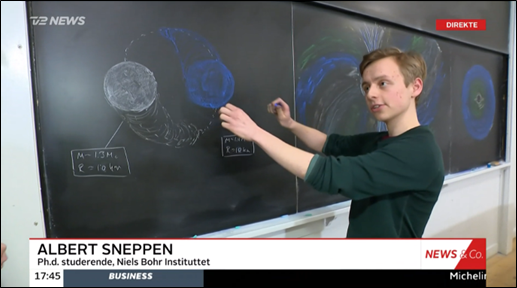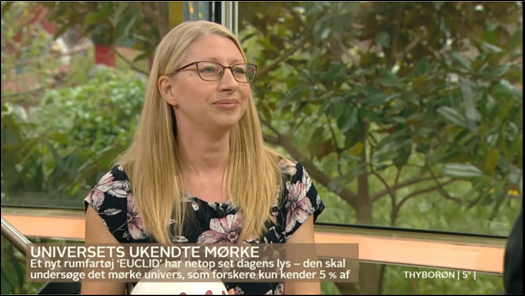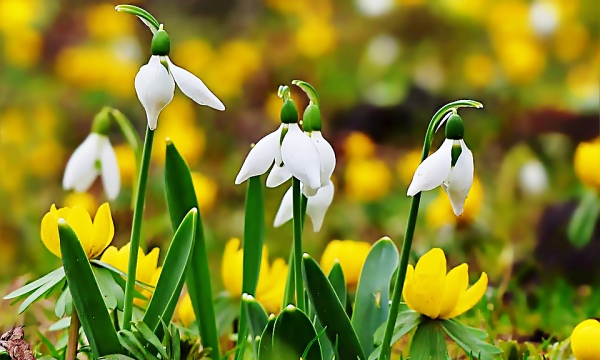Meet Kate Gould - new member of the 1st Author Pub-Club!

I am Katriona (Kate) Gould (she/her), a third year PhD student at DAWN-NBI supervised by Gabe Brammer and Francesco Valentino.
A fun fact about me is that I have run a lap of the inside of the Lovell Telescope (yes, I asked permission first, and yes, I have video evidence).
I became interested in this topic for the publication because I did a summer internship where I wrote an algorithm to find high redshift quiescent galaxies lensed by foreground galaxies. Before that, I wasn’t aware that they existed so early in the universe, and the literature didn’t say much about how they got there, so I decided to do a PhD to answer the question “why did galaxies first start to quench?” (Unfortunately I still can’t tell you…). But, after spending some time looking at high redshift quiescent galaxies in the latest COSMOS2020 catalog, I realised I first had to answer a much more pressing question: how do you efficiently select them from a data set? This led to my first paper, where I came up with a new selection method that is designed to effectively select high redshift quiescent galaxies from photometric catalogs.
[ I plan to use this method to select quiescent galaxies in JWST data and study them in greater detail, and have already assisted Francesco with his work on producing an atlas of high redshift quiescent galaxies in public JWST fields, selected both using a classical method (UVJ) and my new method. ]
The Lovell Telescope
I think the most exciting finding from my paper is not necessarily about the galaxies themselves, but about methods: it’s only because of the developments in data quality, computing, machine learning and open source software that I was able to develop this method. We are at a really exciting time in science where we can use complex tools on beautiful data in a very easy way, which was not possible even 15 years ago when people first started finding high redshift quiescent galaxies. My method provides a fast, open source alternative way to reliably select galaxy populations, which has proved quite difficult in the past.
OPPORTUNITIES & CALLS
Webinars/Workshops/Conferences:
_________________________________________________________________________________________________________________
| ♦ JWST Workshop at Kavli Institute for Cosmology, Cambridge | 20-24 Mar | Link is here |
| ♦ Present and Future of Line-Intensity Mapping Workshop at MPI | 18-21 Apr | Link is here |
| ♦ Conference "Escape of Lyman Radiation From Galactic Labyrinths" | 18-21 Apr | Link is here |
| ♦ The Danish Science Festival 2023 | 22-28 Apr | Link is here |
| ♦ Webinar - UCPH: Introduction to Funding Opportunities | 04 May | Link is here |
| ♦ ZOOM Meeting: ERC Starting Grant - Introduction Online | 11 May | UCPH link |
| ♦ ADAM 2023 in Fredericia (Annual Danish Astronomy Meeting) | 07-08 Jun | TBD |
| ♦ “First Light” Conference in Boston | 12-16 Jun | Link is here |
| ♦ The SCMA Conference (Penn State University) | 12-16 Jun | Link is here |
| ♦ Euclid Meeting 2023 | 19-23 Jun | TBD |
| ♦ DAWN Summit 2023 | 26-28 Jun | TBD |
| ♦ Scientific Communication in Astronomy School 2nd Edition - Italy | 02-06 Oct | Link is here |
| ♦ "Young Astronomers on Galactic Nuclei" (YAGN23) in Italy | 18-20 Oct | Link is here |
Grants:
_________________________________________________________________________________________________________________
| ♦ The VILLUM Foundation (Synergy Programme) | 02 Mar | DTU link | UCPH link |
| ♦ DFF (Sapere Aude 2023) | 23 Mar | DTU link | UCPH link |
| ♦ Inge Lehmann’s Grant | 01 Apr | DTU link | UCPH link |
| ♦ EU Horizon Europe - ERC Advanced Grant | 23 May | ERC link | UCPH link |
| ♦ VILLUM Experiment | 15 Mar | DTU link | UCPH link |
| ♦ The Carlsberg Foundation: Int. Fellowships | 01 Apr | DTU link | UCPH link |
| ♦ VILLUM Foundation/Young Investigator (preliminary) | 08 Jun | DTU link | UCPH link |
| ♦ EU Horizon Europe - ERC Starting Grant (preliminary) | 25 Oct | DTU link | UCPH link |



 Bitten Gullberg, Albert Sneppen, and Peter Laursen for their individual presentations on the Danish morning show Go'Morgen Danmark, TV2 News and Kosmopol on TV2!
Bitten Gullberg, Albert Sneppen, and Peter Laursen for their individual presentations on the Danish morning show Go'Morgen Danmark, TV2 News and Kosmopol on TV2!

.png)
 The vintergækker (snowdrop flower) is considered the first flower of the year in Denmark. The white delicate flower can be found in most cities and in Danish nature, where it often blooms in the early days of February. The vintergækker did not naturally belong or grow in Danish nature. The flower naturally grows in Spain in the Pyrenees and in Kaukasus, but the flower was brought to Denmark in the 1400-century by monks and nuns.
The vintergækker (snowdrop flower) is considered the first flower of the year in Denmark. The white delicate flower can be found in most cities and in Danish nature, where it often blooms in the early days of February. The vintergækker did not naturally belong or grow in Danish nature. The flower naturally grows in Spain in the Pyrenees and in Kaukasus, but the flower was brought to Denmark in the 1400-century by monks and nuns.

